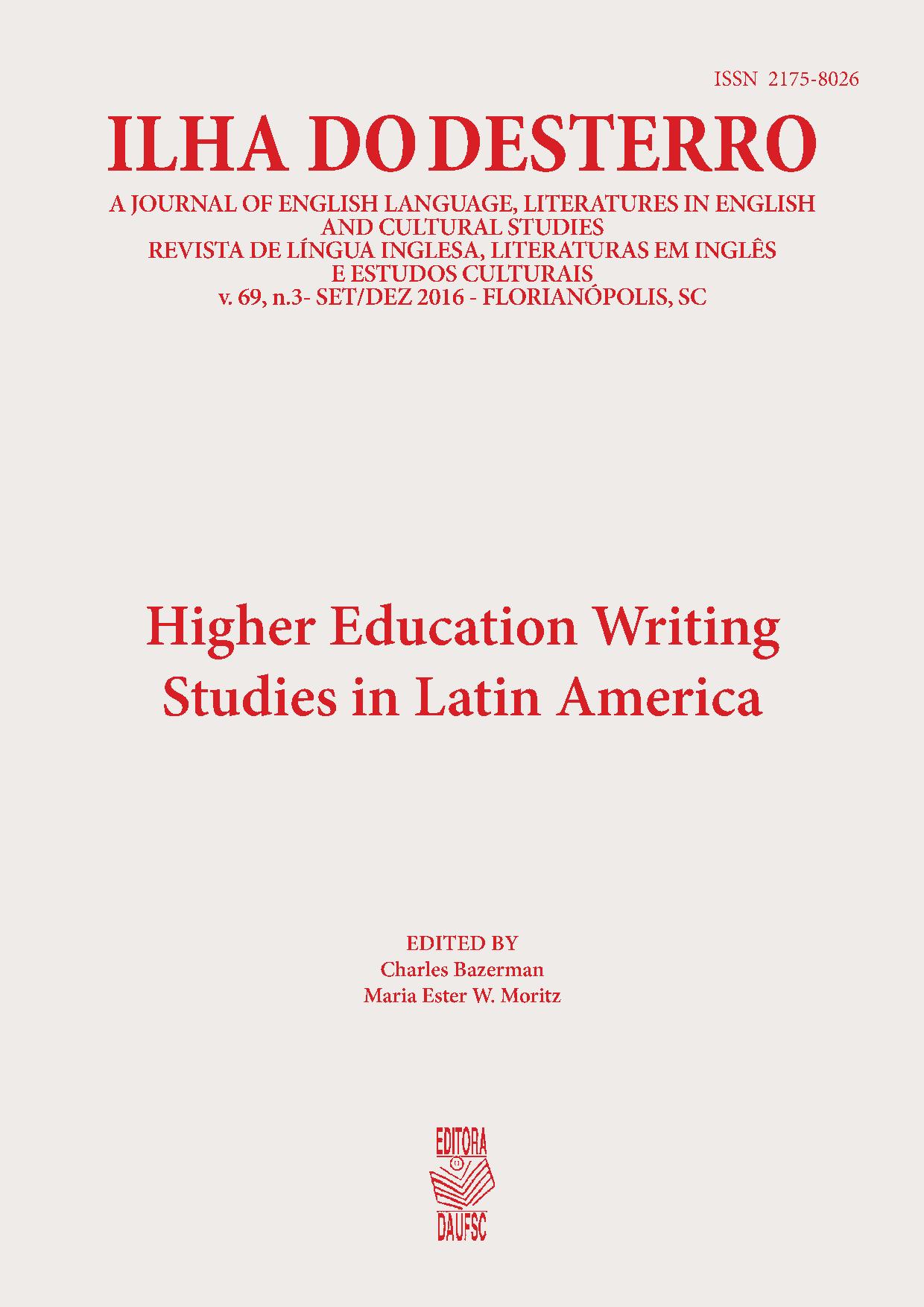Latin-American writing initiatives in engineering from Spanish-speaking countries
DOI:
https://doi.org/10.5007/2175-8026.2016v69n3p223Abstract
This article analyzes Latin-American publications from Spanish Speaking countries to map programs pursued in the Region and then provide a context to envision further research agendas for Latin-American Writing Studies in engineering. The analysis of 22 publications suggests that initiatives and studies in engineering are recent (as of 2009). The sample reveals an emphasis on pedagogically-oriented publications focused on engineering as one field. The trends suggest that the Latin-American writing advocates in engineering might benefit by incorporating theoretical frameworks for a) exploring and understanding different roles of writing across time and curriculum in student learning and by engineering subfields and, b) exploring theoretical approaches to understand genres beyond individual texts (i.e., genre repertoires and genre systems).
References
Adler-Kassner, L. (2014). Liberal Learning, Professional Training, and Disciplinarity in the Age of Educational ‘Reform’": Remodeling General Education." College English, 76(5), 436.
Allen, J. (2010). Mapping institutional values and the technical communication curriculum: A strategy for grounding assessment. In Hundleby, M. N., & Allen, J. (Eds.). Assessment in technical and professional communication. (pp. 39-56). Baywood Publishing Company.
Artemeva, N. (2005). A Time to Speak, a Time to Act A Rhetorical Genre Analysis of a Novice Engineer’s Calculated Risk Taking. Journal of Business and Technical Communication, 19(4), 389-421.
Base internacional bibliográfica sobre Lectura y Escritura - Inicio. (n.d.). Retrieved October 15, 2015, from: http://www.utp.edu.co/vicerrectoria/investigaciones/publicaciones-lectura-escritura/
Bernhardt, S. A. (2002). Active-practice: Creating productive tension between academia and industry. In Mirel, B., & Spilka, R. (Eds.). Reshaping technical communication: New directions and challenges for the 21st century. (pp. 81-90). Routledge
Boettger, R. K., & Lam, C. H. R. I. S. (2013). An Overview of Experimental and Quasi-Experimental Research in Technical Communication Journals (1992–2011). Professional Communication, IEEE Transactions on, 56(4), 272-293.
Carter, M., Ferzli, M., & Wiebe, E. N. (2007). Writing to learn by learning to write in the disciplines. Journal of Business and Technical Communication, 21(3), 278-302.
Elliot, N. & Coppola, N. (2010). Assessment of graduate programs in technical communication. In Hundleby, M. N., & Allen, J. (Eds.). Assessment in technical and professional communication. (pp. 127-161). Baywood Publishing Company.
Ford, J. D., & Newmark, J. (2011). Emphasizing Research (Further) in Undergraduate Technical Communication Curricula: Involving Undergraduate Students with an Academic Journal's Publication and Management. Journal of Technical Writing and Communication, 41(3), 311-324.
ILEES English. (n.d.). Retrieved October 15, 2015, from http://english.ilees.org/
Lerner, N. (2009). The idea of a writing laboratory. SIU Press.
Maylath, B., Grabill, J., & Gurak, L. J. (2010). Intellectual fit and programmatic power: Organizational profiles of four professional/technical/scientific communication programs. Technical Communication Quarterly, 19(3), 262-280.
McDaniel, R., & Steward, S. (2011). Technical communication pedagogy and the broadband divide: Academic and industrial perspectives. Complex worlds: Digital culture, rhetoric, and professional communication, (pp. 195-212). NY: Baywood.
Miller, C. R. (2004). A humanistic rationale for technical writing. Central works in technical communication, 47-54. Oxford University Press.
Monberg, J. (2002). Science and technology studies as a research method. In Gurak, L. J., & Lay, M. M. (Eds.). (2002). Research in technical communication. (pp. 211-229).Greenwood Publishing Group.
Moore. L. J. (forthcoming). Five Essential Principles about Writing Transfer. In Critical Transitions: Writing and the Question of Transfer, ed. Jessie Moore and Chris M. Anson. Parlor Press. Forthcoming 2016.
Poe, M., Lerner, N., & Craig, J. (2010). Learning to communicate in science and engineering: Case studies from MIT. MIT Press.
Quick, C. (2012). From the Workplace to Academia: Nontraditional Students and the Relevance of Workplace Experience in Technical Writing Pedagogy. Technical Communication Quarterly, 21(3), 230-250.
Reave, L. (2004). Technical Communication Instruction in Engineering Schools A Survey of Top-Ranked US and Canadian Programs. Journal of Business and Technical Communication, 18(4), 452-490.
Rounsaville, A. (2012). Selecting Genres for Transfer: The Role of Uptake in Students' Antecedent Genre Knowledge. In Composition Forum (Vol. 26). Association of Teachers of Advanced Composition.
Rude, C. D. (2009). Mapping the research questions in technical communication. Journal of Business and Technical Communication.
Russell, D. R. (2007). Rethinking the Articulation Between Business and Technical Communication and Writing in the Disciplines Useful Avenues for Teaching and Research. Journal of Business and Technical Communication, 21(3), 248-277.
Selber, S. (2004). Challenges facing technical communication teachers in the computer age. In Selber, S. A. Central works in technical communication. (pp. 449-466). Oxford University Press.
Selfe, R. & Selfe, C. (2012). What Are the Boundaries, Artifacts, and Identities of Technical Communication?. In Johnson-Eilola, J., & Selber, S. A. (Eds.). Solving problems in technical communication. (pp. 19-50). University of Chicago Press.
Spilka, R. (2002). Becoming a profession. In Mirel, B., & Spilka, R. (Eds.). Reshaping technical communication: New directions and challenges for the 21st century. (pp. 97-111). Routledge.
Spinuzzi, C. (2012). Working Alone Together Coworking as Emergent Collaborative Activity. Journal of Business and Technical Communication,26(4), 399-441.
Tatzl, D., Hassler, W., Messnarz, B., & Flühr, H. (2012). The Development of a Project-Based Collaborative Technical Writing Model Founded on Learner Feedback in a Tertiary Aeronautical Engineering Program. Journal of Technical Writing and Communication, 42(3), 279-304.
Thralls, C., & Blyler, N. (2002). Cultural studies: An orientation for research in professional communication. In Gurak, L. J., & Lay, M. M. (Eds.). Research in technical communication. (pp. 185-209). Greenwood Publishing Group.
Tuomi-Gröhn, T. & Engeström, Y. (2003). Conceptualizing transfer from standard notions to developmental perspectives. In T. Tuomi-Gröhn & Y. Engeström (Eds.) Between school and work: New perspectives on transfer and boundary crossing. (pp. 19-39). Amsterdam: Pergamon.
Winsor, D. A. (1996). Writing like an engineer: A rhetorical education. Routledge.
Yeats, D., & Thompson, I. (2010). Mapping technical and professional communication: A summary and survey of academic locations for programs. Technical Communication Quarterly, 19(3), 225-261.




